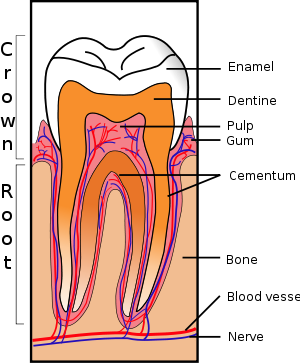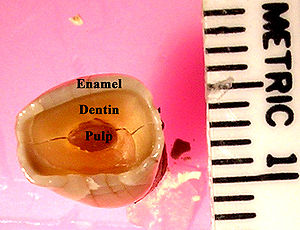Tooth sensitivity is a common dental condition where the teeth becomes extremely sensitive to hot and cold, leading to tooth pain. It affects quite a number of adults, sometimes affecting their lifestyle where certain food with extreme temperatures such as ice-cream or hot coffee needs to be taken cautiously or in some cases, avoided completely.
Cause of tooth sensitivity
Tooth sensitivity occurs due to the exposure of dentinal tubules layer of the teeth which is usually protected by enamel. There are a range of factors that can contribute to dentine exposure, such as tooth grinding, broken tooth, tooth erosion, defective tooth filling, tooth whitening, tooth straightening, dental crown or bridge work and so forth. These are explained as followed:

- Sagittal section of a tooth showing different components
Tooth clenching and grinding or otherwise known as bruxism is a parafunctional habit that places a large amount of force on tooth structure. The force applied during tooth grinding is far much greater than the force one would use for chewing, causing unnecessary stripping of tooth enamel. Thinning of enamel usually occurs gradually but in extreme cases, fragile or cracked tooth structure can actually get chipped off, leaving large areas of exposed dentine.
A broken tooth due to trauma or tooth grinding, as mentioned causes a sudden exposure of dentine and the area involved is usually large. This is where tooth sensitivity related pain will be presented acutely. Sudden tooth sensitivity is generally very uncomfortable and will require some dental intervention.
Tooth erosion is a common reason behind sensitive tooth as dietary acids from food or gastric reflux that has very low pH can gnaw away tooth enamel and dentine. Tooth erosion related tooth sensitivity has an easily recognisable sign where the affected tooth surface dips into dentine like a bowl, giving it a ‘scooped out’ appearance.
Defective or leaky tooth filling can also give rise to tooth sensitivity as it does not provide adequate seal of tooth structure, allowing formation of micro or macro gaps between tooth structure and tooth filling material. This gap allows communication from exposed dentine to the oral cavity, leading to sensitive tooth. Another way that a tooth filling can lead to sensitivity is when the filling material is inadequately handled; leading to direct pulpal sensitivity or more commonly known as toothache. This is not to be confused with the usual tooth sensitivity as they have significantly different management and outcomes.
Sensitive teeth after cleaning are also common due to the nature of cleaning or scaling process which removes tartar or calculus adhering to tooth structure. Though this is a good thing, this may mean the exposure of uncovered dentine sites which have been ‘protected’ by tartar, hence causing tooth sensitivity.
Tooth sensitivity is not uncommon in people who have undergone tooth whitening treatment. This is due to the material being used to bleach teeth, which can lead to thinning of enamel in order to remove stains. Â Repetitive tooth whitening is hence not recommended to minimise occurrence of sensitive tooth. It is also important to note that some bleaching material may be more abrasive than others, hence more likely to cause tooth whitening sensitivity problems.

Dentine and pulp exposure as a result of tooth grinding
Tooth straightening can also cause pressure related tooth sensitivity due to associated tooth movement. Tooth movement places pressure on teeth, which can sometimes cause nerve to be more sensitive and responsive but this is relatively uncommon as most of the time it causes teeth to be less sensitive. Movement of teeth may sometimes also expose certain uncovered dentine sites, leading to sensitive tooth.
With age, our teeth also tend to get thinner through everyday wear and tear. Also our gums tend to receed, leading to exposed root surface cover by a layer known as cementum. With incorrect toothbrushing, this layer is easily removed, leading to exposed underlying dentine.
All these factors lead to one common outcome: that is the exposure of dentine. Such exposure creates a direct communication from the mouth to the pulp or nerve of the tooth. Tooth dentine is porous and contains fluid channels through it, hence allowing some molecules to pass through it. Any stimulus in the mouth such as hot and cold food has the potential to affect dentine through this communication. Stimulus can cause fluid movement inside porous dentinal structure. The changes in fluid movement places pressure on nerve cell endings from the pulp which are embedded in dentine. Such pressure causes temporary deformation of the nerve cell. This deformation leads to the activation of nerve endings in the pulp of the tooth. The activated nerve in the tooth is only capable of registering one type of sensation, which is pain, irrespective of what the stimulus may be. This stems the basis for tooth sensitivity, also otherwise known as the hydrodynamic theory, which is most widely accepted and acknowledged.
Article to be continued in Part 2



Pingback: All about tooth sensitivity: Part 2 | Intelligent Dental
Good post and this mail helped me alot in my college assignement. Gratefulness you as your information.